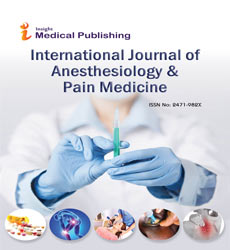Stress Symptom Measures with Drug Consumption
Roya Karimi*
Department of Anesthesiology, Seattle Research Institute, Washington, USA
- *Corresponding Author:
- Roya Karimi
Department of Anesthesiology,
Seattle Research Institute, Washington,
USA,
E-mail: rokarimi@gmail.com
Received date: February 20, 2023, Manuscript No. IPAPM-23-16559; Editor Assigned date: February 23, 2023, PreQC No. IPAPM-23-16559 (PQ); Reviewed date: March 06, 2023, QC No. IPAPM-23-16559; Revised date: March 13, 2023, Manuscript No. IPAPM-23-16559 (R); Published date: March 20, 2023, DOI: 10.35841/2471-982X.9.1.95
Citation: Karimi R (2023) Stress Symptom Measures with Drug Consumption. Int J Anesth Pain Med Vol. 9 No. 1: 95.
Description
Using a web-based questionnaire, RMDQ was measured at baseline, six weeks, three, six, and nine months. Higher scores (0-24) showed higher LBP-related incapacity. The primary outcome of the RCT was the mean difference in RMDQ between the intervention and control groups at three months. A decrease of 4 points was considered to be a clinically meaningful improvement in the RMDQ score, despite some debate in the literature.
The 10-item Pain Self-Efficacy Questionnaire (PSEQ) was one of the secondary outcomes. range 0–60), which has strong psychometric properties in LBP populations, participants are asked to rate how confident they are in participating in activities despite pain. Higher scores indicate greater self-assurance in one's capacity to endure suffering; and secondly, the GPE, or Global Perceived Effect range −5 to 5) scale gauge of generally improvement, where positive scores demonstrate LBP improvement, and negative scores a decay. PSEQ was measured at the beginning; At 3, 6, and 9 months, PSEQ and GPE were all measured.
On a 5-point Likert scale, with 1 being the lowest and 5 being the highest, satisfaction with the app was assessed at a single point after four months by asking participants: What is your opinion of the selfBACK app? Participants who received a score of 4 or 5 were considered "satisfied" for the purposes of the analysis. Application commitment was estimated by the quantity of week by week self-administration plans members made on the application. ' Participants who completed six or more selfmanagement plans within the first three months following randomization were considered engaged.
Trigeminal Neuralgia Characteristics
Typically, trigeminal neuralgia (TN) is characterized by brief, sporadic bouts of severe facial pain in any of the CN V branches. Old style TN is credited to a neurovascular struggle (NVC) between a cerebral vessel and CN V in the root passage zone, albeit extra components, for example, particle channel aggravations and neuroinflammation with arachnoiditis may likewise be associated with sickness movement. Other subtypes of TN with slightly different pathophysiologies include secondary TN caused by, for example, lesions of the CN V pathways in MS and idiopathic TN when no specific cause is found.
Despite the fact that TN is still a rare neurological condition, only a small number of studies have attempted to comprehensively examine its epidemiology. The incidence of TN has also been estimated to be rather broad, ranging from 4 to 29 cases per 100,000 person-years in these few studies. Significant variations in the study methodology as well as the population cohorts can account for this substantial variation. First, some previous studies have looked at only primary care registries, while others have looked at both hospital and primary care cohorts together. This is important because, in addition to case determination, TN is frequently diagnosed in the neurology department. Due to the numerous differential diagnoses for facial pain, including trigeminal neuropathy, dental pain, and atypical facial pain, diagnostic accuracy may be low, especially in the primary care setting, with a high rate of false positives and negatives. This limitation is especially important for studies that used case numbers with a TN diagnostic code, which might not be reliable, to calculate incidence rates. This problem has been addressed in some studies through pro- or retrospective case validation.
Intense Facial Pain
The incidence has ranged from 8 to 29 cases per 100,000 person-years even in these studies. Regional differences may account for some of the variation in TN incidence, in addition to the methodological differences between the studies. Therefore, high-quality epidemiological studies from various parts of the world are essential for gaining a better understanding of TN epidemiology. As a result, the primary objective was to ascertain the relationship between age and gender and the prevalence of TN in a county in central Sweden. The secondary objective was to learn more about this cohort's TN characteristics, such as side and involved CN V branches.
Two of the authors (TSW [Neurosurgical resident] and SAH [Senior consultant in Neurosurgery]) conducted a retrospective review of the medical records of the selected patient cohort, which included 349 patients who were diagnosed with TN (ICD G50.0), 47 patients who were diagnosed with atypical facial pain (G50.1), 28 patients who were diagnosed with other disorders of the trigeminal nerve (G50.8), and two patients who were diagnosed with an unspecified disorder Cohen's Kappa was 0.77, indicating moderate to strong interrater reliability. TSW and SAH differ on the TN determination in 47 cases, in which a third creator (HE [Senior Specialist in Neurosurgery]) went with the last choice in regards to the TN conclusion. Patients' reported ages and incidence rates were based on when they were diagnosed (between 2009 and 2017). 159 people were thought to have TN, with 157 having a G50.0 code and 2 having a G50.1 code. 187 people with a G50.0 code, or 54 percent, were thought to have another diagnosis other than TN, and 52 people, or 15 percent, were thought to have TN but were diagnosed before 2009. Information on the characteristics of TN (side, branch, etc.) were taken out of these medical records as well.
Open Access Journals
- Aquaculture & Veterinary Science
- Chemistry & Chemical Sciences
- Clinical Sciences
- Engineering
- General Science
- Genetics & Molecular Biology
- Health Care & Nursing
- Immunology & Microbiology
- Materials Science
- Mathematics & Physics
- Medical Sciences
- Neurology & Psychiatry
- Oncology & Cancer Science
- Pharmaceutical Sciences
